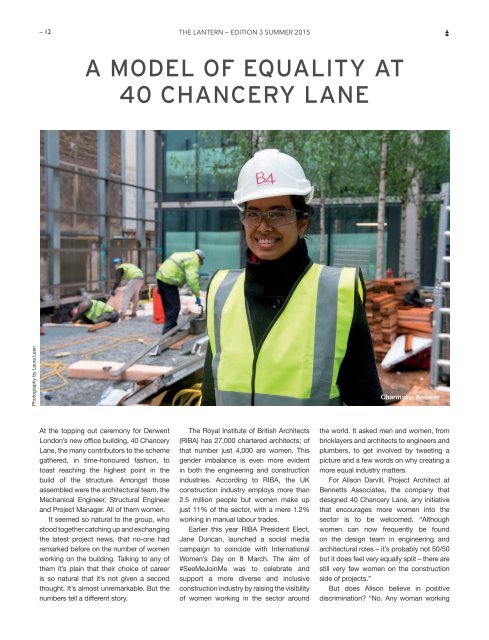THE LANTERN
Lantern-3
Lantern-3
You also want an ePaper? Increase the reach of your titles
YUMPU automatically turns print PDFs into web optimized ePapers that Google loves.
– 12<br />
<strong>THE</strong> <strong>LANTERN</strong> – EDITION 3 SUMMER 2015<br />
A MODEL OF EQUALITY AT<br />
40 CHANCERY LANE<br />
Photography by Laura Lean<br />
Charmaine Knower<br />
At the topping out ceremony for Derwent<br />
London’s new office building, 40 Chancery<br />
Lane, the many contributors to the scheme<br />
gathered, in time-honoured fashion, to<br />
toast reaching the highest point in the<br />
build of the structure. Amongst those<br />
assembled were the architectural team, the<br />
Mechanical Engineer, Structural Engineer<br />
and Project Manager. All of them women.<br />
It seemed so natural to the group, who<br />
stood together catching up and exchanging<br />
the latest project news, that no-one had<br />
remarked before on the number of women<br />
working on the building. Talking to any of<br />
them it’s plain that their choice of career<br />
is so natural that it’s not given a second<br />
thought. It’s almost unremarkable. But the<br />
numbers tell a different story.<br />
The Royal Institute of British Architects<br />
(RIBA) has 27,000 chartered architects; of<br />
that number just 4,000 are women. This<br />
gender imbalance is even more evident<br />
in both the engineering and construction<br />
industries. According to RIBA, the UK<br />
construction industry employs more than<br />
2.5 million people but women make up<br />
just 11% of the sector, with a mere 1.2%<br />
working in manual labour trades.<br />
Earlier this year RIBA President Elect,<br />
Jane Duncan, launched a social media<br />
campaign to coincide with International<br />
Women’s Day on 8 March. The aim of<br />
#SeeMeJoinMe was to celebrate and<br />
support a more diverse and inclusive<br />
construction industry by raising the visibility<br />
of women working in the sector around<br />
the world. It asked men and women, from<br />
bricklayers and architects to engineers and<br />
plumbers, to get involved by tweeting a<br />
picture and a few words on why creating a<br />
more equal industry matters.<br />
For Alison Darvill, Project Architect at<br />
Bennetts Associates, the company that<br />
designed 40 Chancery Lane, any initiative<br />
that encourages more women into the<br />
sector is to be welcomed. “Although<br />
women can now frequently be found<br />
on the design team in engineering and<br />
architectural roles – it’s probably not 50/50<br />
but it does feel very equally split – there are<br />
still very few women on the construction<br />
side of projects.”<br />
But does Alison believe in positive<br />
discrimination? “No. Any woman working


